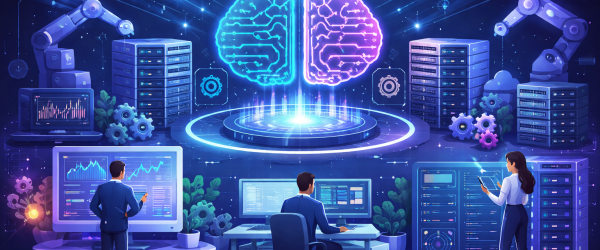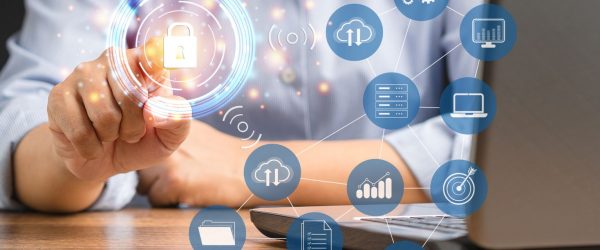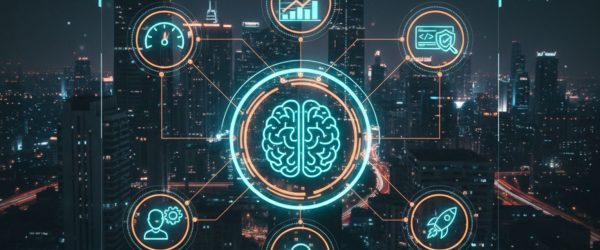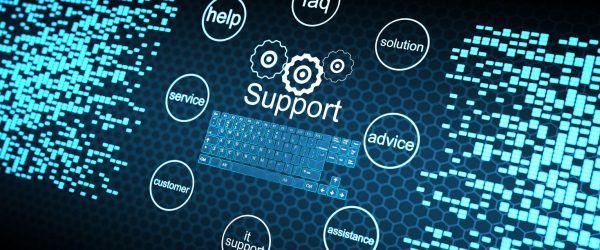Introduction
In today’s digital-first economy, IT operations have moved from being a back-office function to a business-critical enabler. The average cost of IT downtime is estimated at $5,600 per minute, according to Gartner — and for global enterprises, that cost can soar into millions. As systems grow more distributed (multi-cloud, microservices, hybrid infrastructure), traditional monitoring falls short.
This is where AI-driven observability comes in — enabling IT teams to detect, analyze, and resolve issues faster, with predictive capabilities that go beyond dashboards and alerts.
What is AI-Driven Observability?
Observability is more than monitoring — it’s about understanding the why behind system behavior. It combines three key data pillars:
- Metrics: Numerical data on system performance (CPU, memory, latency)
- Logs: Event records that provide detailed insights into system operations
- Traces: End-to-end view of requests across microservices
AI-driven observability enhances this process by:
- Correlating massive volumes of data from multiple sources in real time
- Detecting anomalies automatically with machine learning
Recommending or triggering remediation actions to reduce Mean Time to Resolution (MTTR)
Why IT Leaders Are Turning to AI-Driven Observability
1. Faster Root Cause Analysis
According to Forrester, organizations using AI-powered observability see 30–40% reduction in MTTR because AI correlates events, traces, and logs far faster than human teams can.
2. Proactive Problem Prevention
AI models detect anomalies before they escalate, preventing outages. Predictive analytics can alert IT teams of potential capacity issues or service degradation hours — even days — in advance.
3. Improved Productivity
AI-driven observability reduces alert fatigue by filtering noise and prioritizing only critical incidents. McKinsey research shows teams adopting AIOps and AI observability report 20–30% productivity gains across IT Ops teams.
4. Better Customer Experience
Reduced downtime and faster resolution mean better SLA compliance and improved user experience — a direct impact on revenue and retention.
Core Components of AI-Driven Observability
| Component | Purpose | Examples / Tools |
| Data Collection Layer | Gathers logs, metrics, and traces | Prometheus, OpenTelemetry |
| AI/ML Engine | Detects anomalies, correlates events | AIOps Platforms, Custom ML Models |
| Visualization & Insights | Presents real-time dashboards and reports | Grafana, Kibana |
| Automation & Remediation | Triggers alerts or self-healing workflows | PagerDuty, Ansible, Terraform |
| Feedback Loop | Improves accuracy using past incident data | Reinforcement Learning Models |
Real-World Use Cases
1. Predictive Outage Prevention
Detecting disk utilization trends and triggering capacity expansion before systems hit 90% usage — avoiding downtime.
2. Auto-Scaling Resources
Monitoring real-time demand and scaling microservices automatically during peak traffic.
3. Anomaly Detection in Security
Identifying unusual traffic patterns that might indicate a security breach.
4. Root Cause Analysis Across Multi-Cloud
Correlating logs across AWS, Azure, and on-prem systems to pinpoint a failing service within seconds.
Business Impact of AI-Driven Observability
| Metric | With Traditional Monitoring | With AI-Driven Observability |
| MTTR (Mean Time to Resolution) | Hours | 30–40% faster |
| Incident Frequency | High due to missed early signals | Reduced via proactive detection |
| Ops Productivity | Manual triage & firefighting | 20–30% productivity improvement |
| Customer Satisfaction | SLA breaches common | Higher uptime & better experience |
Challenges & Best Practices
- Avoid Alert Overload: Use AI to prioritize critical incidents.
- Ensure Data Quality: Garbage in = garbage out. Observability depends on clean, complete data.
- Start Small, Scale Gradually: Begin with critical services, then expand to full-stack coverage.
- Human-in-the-Loop: Keep humans involved in decision-making for high-impact remediations until confidence in automation is high.
The Future of IT Operations
AI-driven observability is a stepping stone toward autonomous IT operations (NoOps) — where systems self-detect, self-heal, and self-optimize with minimal human intervention.
According to Grand View Research, the AIOps market is expected to grow at a CAGR of 18.7% through 2030, proving that AI-first observability will become the new standard for enterprise IT.
Conclusion
IT environments are more complex than ever, and downtime costs are higher than ever. AI-driven observability provides IT leaders with the visibility, intelligence, and automation needed to stay ahead of issues — not just react to them.
By combining metrics, logs, and traces with machine learning, organizations can accelerate root cause analysis, predict outages before they occur, and optimize costs — all while improving customer experience.







